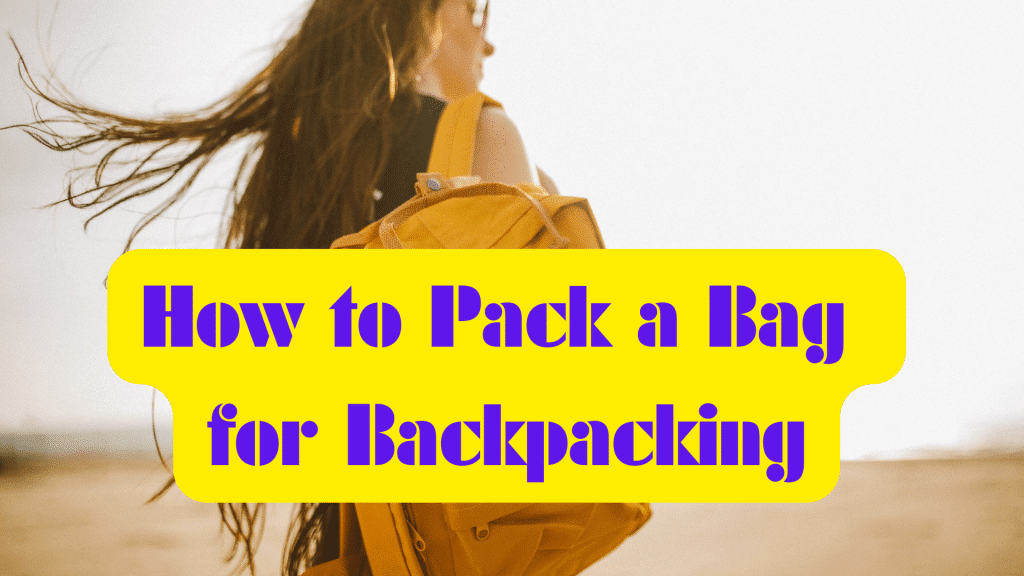
But before you head out on your next backpacking trip, you should know a few things. In this article, you’ll learn how to pack a bag for backpacking, what to bring, and how to plan your trip. Let’s get started!
It’s a big world out there; we want to see everything. As outdoor enthusiasts, we can explore the world in ways many don’t. We can hike to remote mountain lakes, sleep under the stars, and climb the peaks.
Backpacking is a great way to get out and explore the world and a relatively simple way to travel. You don’t have to worry about hotels or rental cars, just grab your backpack and hit the trail.
Learn essential strategies on “How to Pack a Bag for Backpacking” to ensure your journey is hassle-free. Need more tips to lighten your load? Explore our guide on “How to Make Backpack Less Heavy: Tips and Tricks” for practical advice on reducing weight and enhancing comfort during your outdoor adventures.
Importance of Efficient How to Pack a Bag for Backpacking Trips
Packing efficiently is a skill that takes time and practice to develop. If you’re not used to traveling with a backpack, you’ll quickly learn how important it is to know how to pack a bag for backpacking in a way that keeps your load balanced and relatively light.
You’ll also want to ensure you have all the necessary gear and clothing without overpacking. Backpacking is very different from traveling with a suitcase; the gear you choose and how you pack it will greatly impact your overall experience.
Essential Gear
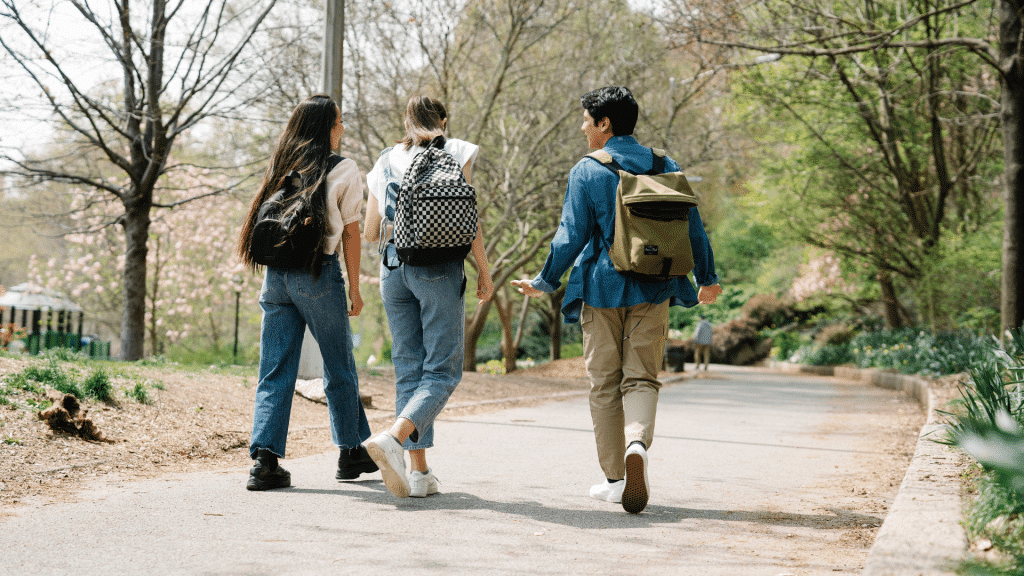
The gear you pack will depend on what type of trip you’re going on and the weather. You’ll want to keep your pack as light as possible, so it’s crucial to know how to pack a bag for backpacking by focusing on essentials.
If you’re taking a guided trip, the company you’re traveling with will likely provide a gear list. If you’re planning your own adventure, here are some of the basics you’ll need to bring:
• Tent, sleeping bag, and pad
• Stove, fuel, and cookware
• Food
• Water bottles or a hydration system
• Water filter or purification tablets
• Clothing (more on that below)
• Map and compass
• First-aid kit
• Headlamp and extra batteries
• Multi-tool or knife
• Sunscreen
• Insect repellent
• Toilet paper
• Trash bag
• Firestarter (matches, lighter, or fire starter)
Checklist of Necessary Items for Backpacking – Clothing – Footwear – Shelter
The first thing to consider when packing a bag for backpacking is the weight of your gear. This will help you decide what to bring and what to leave at home. Packing light is especially important if you’re going to be hiking long distances over the course of your backpacking trip. Knowing how to pack a bag for backpacking efficiently is key.
Here’s a list of the basic gear you’ll need to pack for a backpacking trip:
• Map and compass
• First-aid kit
• Multi-tool or knife
• Firestarter and matches
• Headlamp and extra batteries
• Sun protection
• Insect repellent
• Water purification
• Food and snacks
• Stove and fuel
• Cookware and utensils
• Food Storage
• Trash bags
• Personal care items
• Toilet paper
• Hand sanitizer
• Towel
• Toothbrush and toothpaste
• Soap
• Feminine products
• Prescription medications
• Sunglasses
• Repair kits
• Sewing kit
• Gear repair items
• Duct tape
• Safety pins
• Zip ties
• Bungee cords
• Gear and clothing storage
• Dry bags
• Stuff sacks
• Compression sacks
Clothing
When packing a bag for backpacking, it’s important to consider the weather and terrain where you’ll be hiking. This will help you decide what clothing to pack. You’ll also want to consider how long your trip will be, as well as how many changes of clothing you’ll need. Understanding how to pack a bag for backpacking efficiently is crucial for a successful adventure.
Here’s a list of the basic clothing you’ll need to pack for a backpacking trip:
• Moisture-wicking base layers
• Quick-drying hiking pants or shorts
• Moisture-wicking t-shirts
• Long-sleeve shirts
• Insulating layers
• Fleece jacket
• Insulating hat
• Insulating gloves
• Waterproof and windproof jacket
• Waterproof and windproof pants
• Hiking socks
• Liner socks
• Gaiters
• Hiking boots
• Camp shoes
• Sandals
Sleeping Bag- Cooking Equipment – First Aid Kit – Navigation Tools
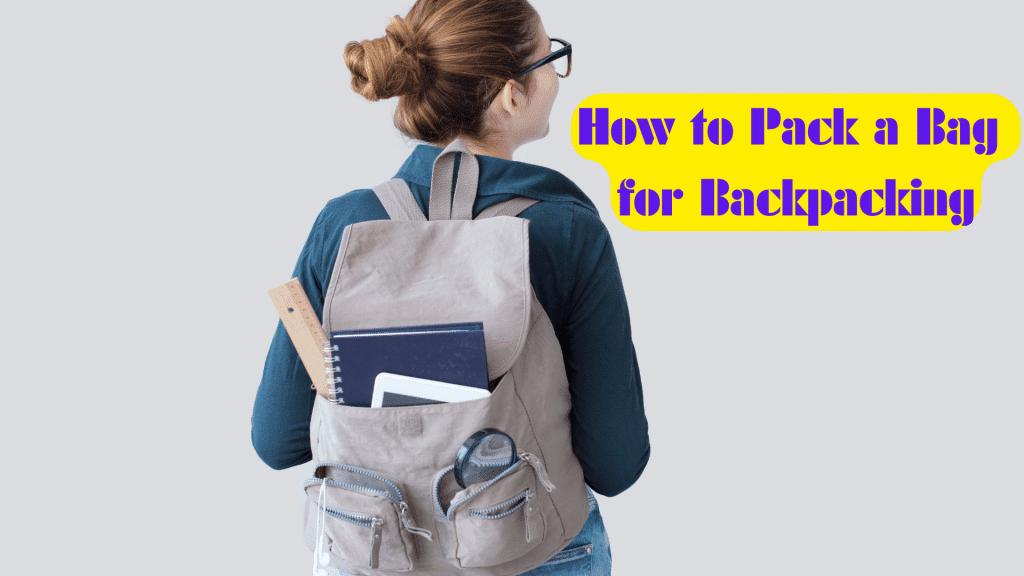
Don’t forget to pack your tent! Tents are considered a “common” item, but if you’re backpacking with a group, you’ll want to ensure enough tents for everyone. If you’re going to be hiking in a group, it’s a good idea to divide up the gear so that one person doesn’t have to carry everything. Understanding how to pack a bag for backpacking efficiently ensures you have all the necessary gear without overburdening yourself.
Packing Techniques
You can use a few different packing techniques to help you pack everything you need into your bag. Here are the most popular methods for how to pack a bag for backpacking:
• The Compression Method: This method involves using compression sacks to squeeze the air out of your clothes and sleeping bag to make them more compact. You can also use a vacuum sealer to pack your clothes.
• The Rolling Method: Rolling your clothes instead of folding them can help you save space in your bag. This method is also great for preventing wrinkles.
• The Cubes Method: Packing cubes is a great way to organize your clothes and keep them from wrinkling. You can also use them to compress your clothes.
• The Layering Method: Start with your sleeping bag at the bottom of your bag and then add your heaviest and bulkiest items. Then, fill in the gaps with your lighter items and smaller items.
Utilizing Packing Cubes and Compression Sacks – Roll vs. Fold Method
Utilizing packing cubes and compression sacks
Packing cubes and compression sacks are necessary for anyone looking to travel light. Packing cubes will help you keep your clothes and gear organized, and compression sacks will help you save space in your backpack. Knowing how to pack a bag for backpacking efficiently involves utilizing tools like these.
Roll vs. fold method
When it comes to packing clothes, you have two options: the roll method or the fold method. The roll method saves space and prevents wrinkles in your clothes. The fold method is better for keeping your clothes wrinkle-free.
Distributing weight evenly in the backpack
When packing a bag for backpacking, it’s important to remember the bag’s weight. A heavy bag can lead to back pain and fatigue. To avoid this, distribute the weight evenly throughout the bag.
Packing light to maximize mobility
The key to successful backpacking is to pack light. This means bringing only the essentials and leaving the rest at home. By packing light, you’ll be able to move more quickly and easily and less likely to suffer from back pain and fatigue.
Organizing Your Pack
Now that you have all your gear and clothing, you need to organize your pack.
The first thing you need to do is line your pack with a waterproof rain cover. This will protect your gear if you get caught in a downpour.
Next, pack your sleeping bag. If you have a sleeping bag stuff sack, you can pack this at the bottom of your pack, or you can just place your sleeping bag in the bottom. You may consider getting a compression sack if you have a bulky or sleeping bag that doesn’t compress well. This step is essential in mastering how to pack a bag for backpacking effectively.”
After your sleeping bag, pack your sleeping pad. You can strap this to the bottom or top of your pack or slide it into it. If you have a foam sleeping pad, you can simply strap it to the outside of your pack.
Next, you’ll want to pack your tent. If you have a compact tent, you can pack this in the bottom of your pack. If you have a large tent, you can strap this to the outside of your pack.
Now that your sleeping gear is packed, you can start packing your clothing. Start with your base layer and any other clothing you won’t need until you get to camp. Pack these at the bottom of your pack.
After your clothing, you can start packing your food. Be sure to pack your food so it won’t get crushed. You can pack your food in a stuff sack or a plastic bag. You can also use a bear canister.
After your food, you can start packing your gear. Pack your gear in a way that it won’t get crushed. You can pack your gear in a stuff sack or in a plastic bag.
Maintaining Balance and Stability in the Pack
Packing your pack is a skill you will develop over time, but a few basic principles can help you get started. These include knowing how to pack a bag for backpacking efficiently:
• Categorizing items based on frequency of use
• Accessing regularly needed items easily
• Maintaining balance and stability in the pack
Packing your backpack well can make a huge difference in how comfortable it is to carry. A well-packed backpack will feel balanced and stable on your back. This will help you avoid tipping over and help you feel more confident and comfortable as you hike.
Tips for Efficiency
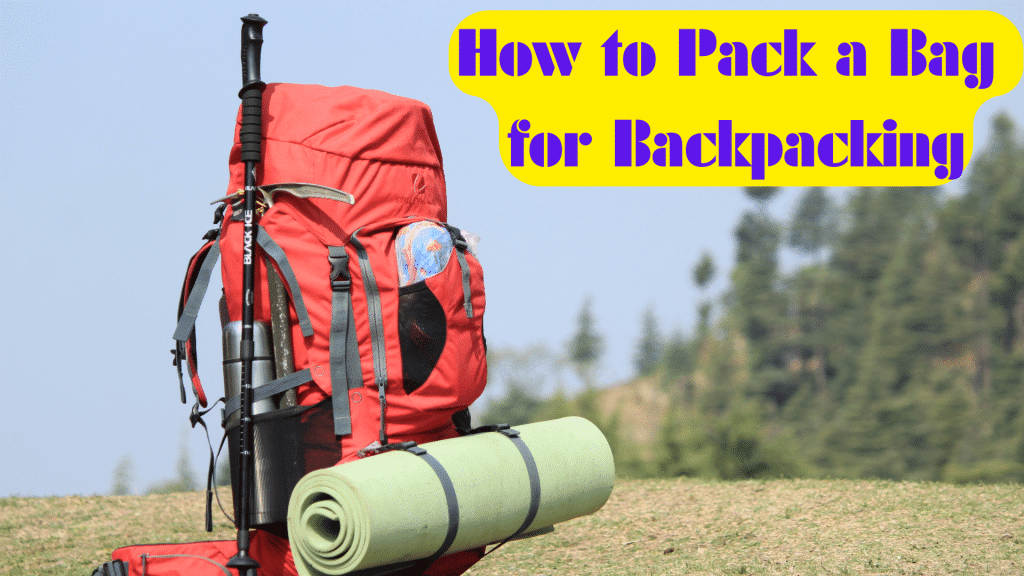
Packing a backpack for the first time can be a little intimidating. But don’t worry; you’ll quickly get the hang of it with a little practice. Here are some tips to help you pack your bag more efficiently and master how to pack a bag for backpacking:
• Use packing cubes to organize your clothes and save your bag space.
• Roll your clothes instead of folding them to save space.
• Pack your sleeping bag first, then your sleeping pad, and then your tent. This will help to create a solid base at the bottom of your pack.
• Pack the heaviest items close to your back in the middle of your pack. This will help you to maintain your balance and keep the weight off your shoulders.
• Pack your rain jacket, first aid kit, and snacks at the top of your pack, where they are easily accessible.
• Use your pack’s side and hip belt pockets to store small items you might need to access quickly, like sunscreen, bug spray, a headlamp, and your phone.
Choosing the Right Backpack Size
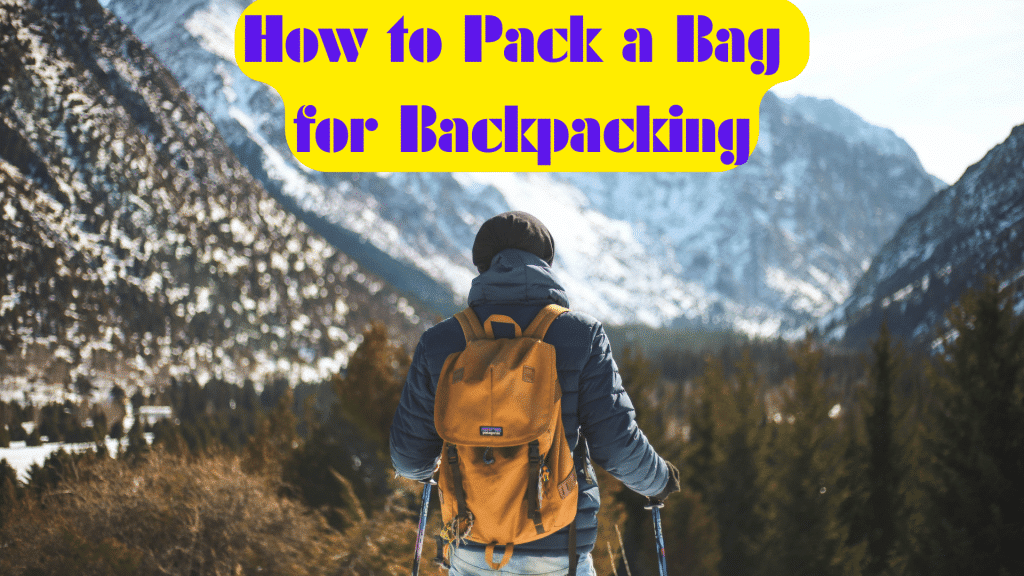
Packing your bag to go camping slightly differs from packing for a backpacking trip. When camping, you can bring whatever you want because you’ll likely have a car to store things in and drive you to the campsite. But when you’re backpacking, you have to carry everything you need for the trip on your back. Understanding how to pack a bag for backpacking is essential for this type of adventure.
Packing a backpack for the first time can be daunting. But once you know the basics, you can pack your bag like a pro.
First off, you’ll need to decide what size backpack you need. This will depend on how many days you’ll be on the trail, your experience level, and personal preferences.
If you’re just starting out, you may want to try a one-night trip with a smaller pack to see how you like it. Experienced backpackers can get away with a smaller pack for multi-night trips if they have lightweight gear.
Regardless of your pack size, you’ll want to pack it correctly. Here are some tips to help you out.
Packing for Various Seasons
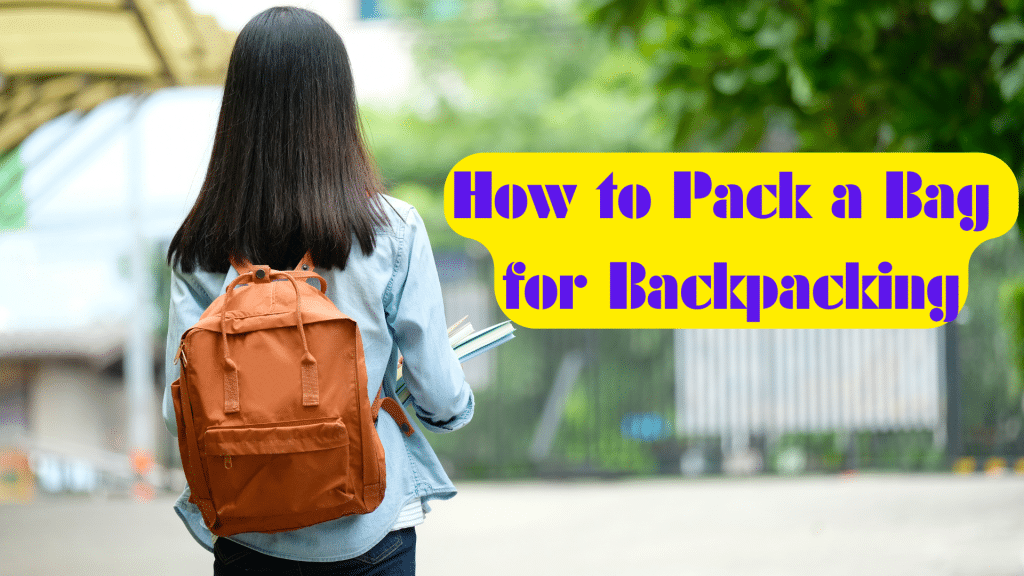
Packing for a winter trip will look different from packing for a summer trip. In the winter, you’ll need to pack many more layers and heavier clothing. In the summer, you can pack a little lighter. Knowing how to pack a bag for backpacking in different seasons is crucial for a comfortable and safe adventure.
However, even if you’re going on a summer trip, it’s still a good idea to pack a warm layer just in case. Weather can be unpredictable, and it’s better to be safe than sorry.
When packing for a summer trip, pack lightweight, moisture-wicking clothing. This will help keep you cool and comfortable on hot days.
Summer Backpacking Essentials – Winter Backpacking Essentials – Spring and Fall Considerations
Spring and fall are the perfect seasons to get out and explore, but you must be more prepared for the weather. Spring and fall seasons can be unpredictable with cold weather, rain, or snow. You’ll need to pack for various conditions and dress in layers. Learning how to pack a bag for backpacking effectively ensures you’re ready for any weather challenges.
For example, in the morning, you might want to wear a light base layer, a long-sleeve shirt, and a puffy jacket. But by the afternoon, you may be down to just a T-shirt.
It’s all about preparing for the worst and hoping for the best.
Packing a bag for backpacking can feel like a lot, but once you get the hang of it, it’s simple. The more you do it, the easier it will become to know what and how to pack it.
The goal is to be comfortable, safe, and prepared. The better you pack, the more you can enjoy your time in the backcountry!
Final Tips for Mastering the Art of Packing for Backpacking Trip Success
We’re all about the benefits of having a tailored packing list, but what about the actual packing process?
We’ve all been there, packing for a trip quickly and shoving things in the bag. Then, when you get to your destination, you must deal with the mess you made. That’s why understanding how to pack a bag for backpacking efficiently is crucial for a stress-free adventure.
Packing a bag for backpacking is a skill that can be mastered, and we’re here to help you do just that.
In this article, we’ll cover the importance of having a tailored packing list and how to create one. Then, we’ll go over packing a bag for backpacking.
We hope this article has helped you learn how to pack a bag for backpacking. Our goal is to make your life easier, and we believe we can do that through our content. Please contact us with any questions about the blog or our app. We would love to hear from you. Safe travels!
Conclusion
The art of packing a bag for backpacking is more than just throwing items into a pack. It involves careful consideration of gear, weight distribution, and organization. By paying attention to details such as the weather, terrain, and duration of the trip, you can tailor your packing strategy to meet the demands of your adventure.
Utilizing tools like packing cubes, compression sacks, and proper layering techniques can maximize space and efficiency in your backpack. Ultimately, mastering how to pack a bag for backpacking allows you to embark on your journey with confidence, knowing that you’re prepared for whatever the wilderness may throw your way.